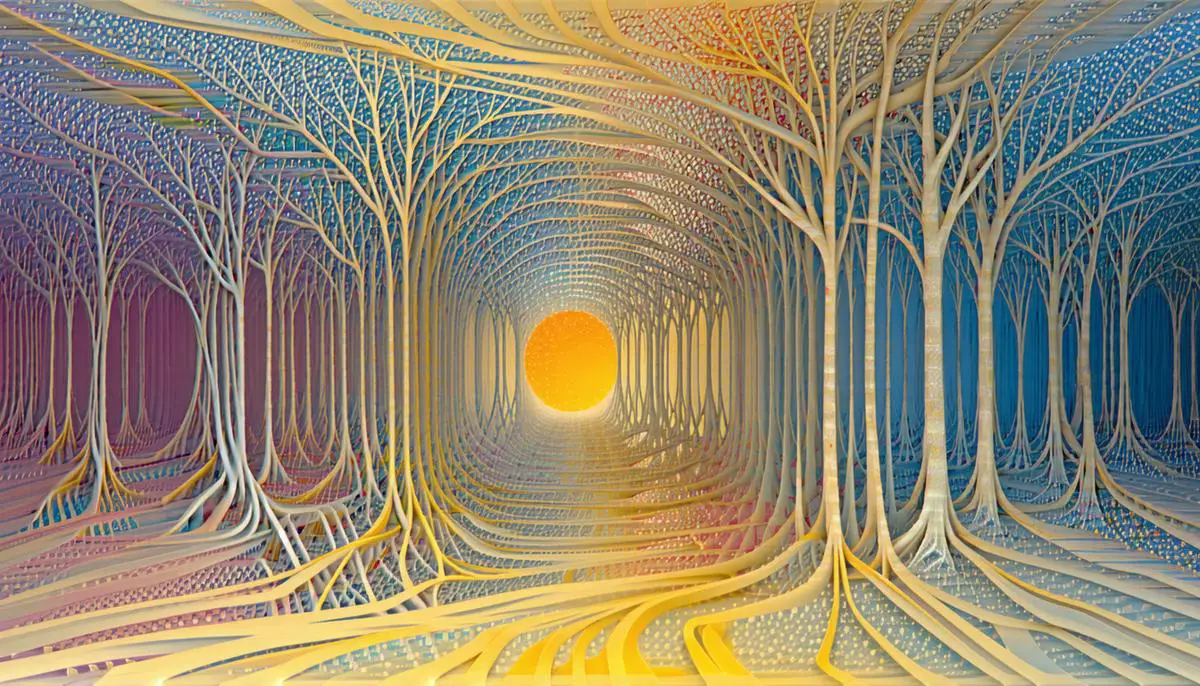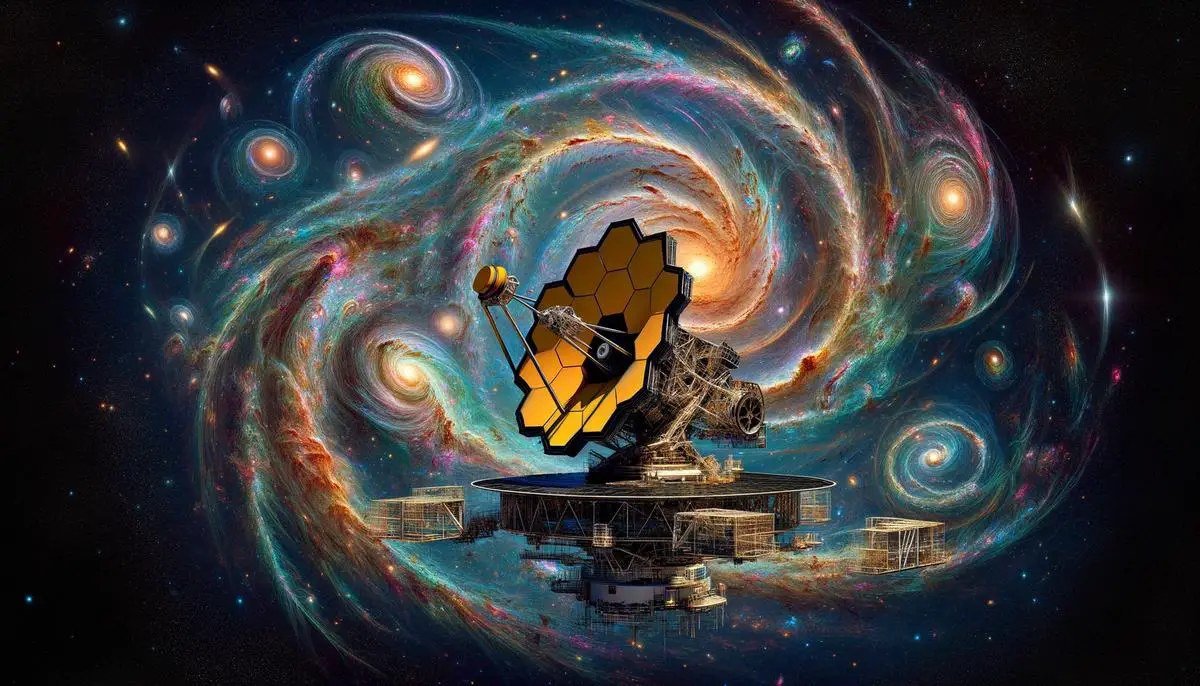Cosmic Microwave Background and the Cold Spot
The Cosmic Microwave Background (CMB), discovered by physicists Arno Penzias and Robert Wilson in 1964, solidified the Big Bang theory and opened new avenues for cosmic exploration. This remnant of the early universe continues to intrigue scientists today.
In the constellation Eridanus lies an intriguing anomaly known as the "Cold Spot". This region is approximately 0.00015 degrees cooler than its surroundings, challenging our understanding of cosmic structure. While initially thought to be caused by a supervoid, current theories suggest more exotic possibilities.
Exotic Explanations for the Cold Spot
- Evidence of our universe interacting with another bubble universe
- Alignment with the multiverse theory
- Potential insights into quantum mechanics and interpretations of reality
The Cold Spot's implications extend to fundamental theories in physics, including the Copenhagen Interpretation and the Many Worlds Interpretation. These theories offer different perspectives on the nature of reality and the behavior of particles at the quantum level.
While definitive proof remains elusive, the Cold Spot continues to intrigue scientists, offering potential insights into the structure and origins of our universe. Its study pushes the boundaries of our cosmic understanding and encourages further exploration of the fundamental nature of reality.

Quantum Mechanics and the Many-Worlds Interpretation
Quantum mechanics challenges our understanding of reality at the subatomic level. The Copenhagen Interpretation, developed by Niels Bohr and Werner Heisenberg, posits that quantum entities exist in a state of probability until observed, at which point they assume a definite state.
In contrast, Hugh Everett III's Many-Worlds Interpretation (MWI) proposes a more radical view: every quantum possibility plays out in its own universe. This theory suggests the existence of parallel worlds, each representing a different outcome of quantum events.
"And in each universe, there's a copy of you witnessing one or the other outcome, thinking — incorrectly — that your reality is the only reality."
– Brian Greene, "The Hidden Reality"
The MWI presents a complex view of reality, where every decision or quantum event creates new branches of existence. While intellectually stimulating, this interpretation faces challenges:
- Reconciling with relativity
- Lack of direct experimental evidence
- Philosophical implications of infinite parallel realities
These quantum theories not only push the boundaries of our understanding but also raise profound questions about the nature of existence and our place in the cosmos. They highlight the vast potential of reality beyond our immediate perception, encouraging continued exploration and inquiry into the fundamental nature of the universe.

Eternal Inflation and Bubble Universes
Eternal inflation theory, proposed by physicist Alexander Vilenkin, suggests that the universe's rapid expansion following the Big Bang continues indefinitely in some regions. This ongoing inflation could create discrete "bubble universes," each potentially governed by its own physical laws and constants.
Key Points of Eternal Inflation Theory:
- Inflation ends at different times in different regions of space
- New bubble universes form as inflation ends in particular areas
- These bubbles cannot contact each other due to continuous expansion
These bubble universes, isolated by inflationary boundaries, might exhibit vastly different properties. Some could harbor life under alien conditions, while others might remain barren. This concept challenges our understanding of cosmic history and the uniqueness of our universe.
Vilenkin explains: "This picture of the universe, or multiverse, as it is called, explains the long-standing mystery of why the constants of nature appear to be fine-tuned for the emergence of life."
The implications of bubble universes are profound, suggesting that our existence might be the result of cosmic chance within a vast multiverse. This theory expands our perspective on the scale of creation and the potential for diverse forms of existence beyond our observable universe.
While speculative, the concept of bubble universes drives scientific curiosity and encourages us to consider the broader context of our cosmic environment. It prompts us to explore the boundaries of our knowledge and imagine the possibilities that lie beyond our current understanding of the universe.

Theoretical Physics and Multiverse Models
String theory and the concept of parallel branes represent cutting-edge ideas in theoretical physics that challenge conventional understanding of the universe. String theory proposes that fundamental particles are actually tiny vibrating strings, potentially existing in up to eleven dimensions.
The notion of parallel branes, or "braneworlds," suggests our universe might be one of many three-dimensional sheets floating in a higher-dimensional space. These branes could theoretically interact, potentially leading to cosmic events as significant as the Big Bang.
Challenges Facing Multiverse Theories:
- Lack of experimental validation for string theory
- Issues of falsifiability in multiverse concepts
- Complexity versus simplicity in explaining cosmic structure
Critics argue that invoking a multiverse may complicate rather than simplify our understanding of the cosmos. The principle of Occam's Razor, which favors simpler explanations, casts doubt on these complex models.
Nevertheless, these theories continue to drive scientific inquiry, expanding our intellectual horizons and encouraging us to consider the vast possibilities of cosmic structure. While they may not provide immediate answers, they propel us towards deeper exploration of the fundamental nature of reality.
"A mathematical structure is something that you can describe in a way that's completely independent of human baggage. I really believe that there is this universe out there that can exist independently of me that would continue to exist even if there were no humans."
– Max Tegmark, MIT
As we continue to investigate these concepts, we remain part of an ongoing scientific narrative that seeks to unravel the mysteries of existence and push the boundaries of human knowledge.
Observational Evidence and Challenges
The James Webb Space Telescope (JWST) represents a significant leap in our ability to observe the cosmos. Its recent observations have sparked interest in the scientific community, particularly regarding the unexpected patterns of early galaxy rotation. This finding challenges our understanding of a random, isotropic universe and hints at possible larger cosmic structures or influences.
However, these observations, while intriguing, remain ambiguous. Alternative theories, such as black hole cosmology, offer competing explanations for cosmic phenomena. The JWST's findings invite us to consider these ideas, balancing excitement with scientific skepticism.
The search for evidence of a multiverse faces substantial challenges:
- Our universe's vastness limits us to indirect observations
- Cosmic horizons remain unexplored
- Even staunch proponents acknowledge the difficulty in obtaining direct evidence
Critics argue that theories resistant to falsification risk veering into pseudoscience, their explanatory power confined to philosophical rather than empirical realms. This tension between possibility and proof exemplifies the ongoing challenges in cosmological research.
Despite these obstacles, the pursuit of knowledge continues. Multiverse theories, while unproven, enrich our understanding and inspire further exploration. They challenge us to expand both our observational capabilities and our conceptual frameworks, driving us to push the boundaries of scientific inquiry.

In contemplating the vastness of our universe, one is reminded of the intricate dance between possibility and reality. The Cold Spot, with its cosmic enigma, invites us to ponder the idea of a multiverse. While definitive proof remains elusive, the pursuit of understanding enriches our journey, urging us to embrace the wonder and curiosity that drive scientific exploration.
"The Cold Spot might be taken as the first evidence for the multiverse – and billions of other universes may exist like our own."
This bold statement by Professor Tom Shanks highlights the tantalizing possibility that our universe might be just one of many. While the concept stretches our imagination, it's rooted in serious scientific inquiry and mathematical models.
As we continue to explore the cosmos with ever-more-powerful instruments like the JWST, we may uncover further clues about the nature of our universe and its potential companions. The journey of discovery is far from over, and each new observation brings us closer to understanding our place in the vast, perhaps infinite, tapestry of existence.

![]()
